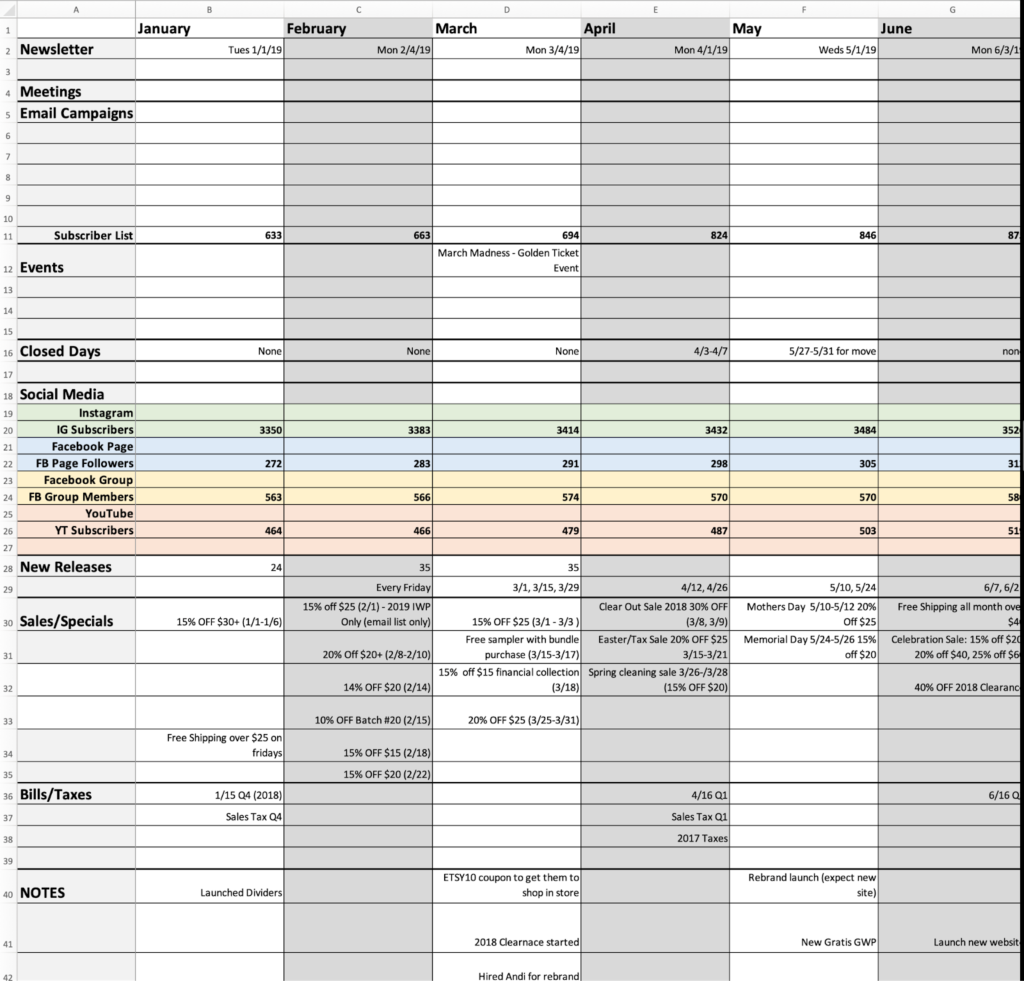We humans are notorious for thinking we’ll remember things accurately when we actually completely suck at it. And as you know, when you’re running a business there’s a lot to remember – meetings, financials, tasks, ideas, etc. So today I wanted to share my strategy for remembering important business metrics, historical data, events and more. Meet the business diary. Okay it’s not really a diary, it’s just a spreadsheet, but it functions a lot like a diary or journal.
Documentation
As I’m sure you already know, to run a successful business you need documentation. From reports and meetings, to standard operating procedures, having things documented is essential, and in some cases required. Documenting business metrics and processes is pretty straightforward, and a quick Google search will give you a variety of template options and ideas to replicate.
But what about documenting the random, yet significant things happening in your business that impact success or you simply don’t want to forget? For example, let’s say you know that weather impacts your sales, where do you record that? Or maybe one year you experiment with closing your business for the week between Christmas and New Years, where do you note that change? This is when a business diary can be a huge help.
What is a Business Diary
I realized pretty early on in my business journey that I needed a way to document various things that would be important to reference later.
Things I track and note in my business diary:
- Closed days
- Extreme weather that impacted sales
- When I launched a new website
- Changes to pricing
- Product launches
- And more…
I started off doing this with a good old fashioned paper planner, but quickly realized that format wasn’t ideal for easy reference and monthly or yearly comparisons and planning. I shifted to using Excel and created a simple spreadsheet I call “Monthly Updates”.
Why a Business Diary
A business diary allows you to “remember” things, plan, set goals, and get a better understanding of changes in sales and various metrics. All of which lets you better plan for the future because you have a clear picture of the past.
For example, if I’m doing a quarterly sales review and notice one day there’s a big spike in sales, but I can’t remember why I refer to my Monthly Updates sheet. I see that I noted one of our customers with a large Instagram following did a post on us that day. Without my trusty business diary I might think the sales spike was random and not see an important incident that positively impacted our revenue.
Essentially a business diary is a place to get all the things out of your head that impact your business and document them in a central place for reference.
How to Create a Business Diary
Now, I’m sure there are much more sophisticated ways to track things like what I mentioned above, but for me I just need a living document to capture it all.
Here’s how I built mine:
First, I create an Excel file and title the worksheet tab with the current year (each year lives in the same document with a new tab/worksheet per year).
Next, I listed the categories of things that I wanted to track down column A in the spreadsheet. This evolved a bit over the years as I figured out more about what was essential for me to track.
Finally, I simply titled each column across the top each month of the year.

This is a very simple, basic spreadsheet that is easy to read and gives me at a glance the highlights and important information I need to see.
You can follow these simple steps to create something similar that is tailored to your needs.
Using Your Business Diary
Each month as part of my reporting I update the spreadsheet for each category. Sometimes I’ll do this during the month if I’m worried I’ll forget about it by month end.
After I update my business diary and complete my other sales reports, I open all the documents and look for trends, patterns, etc. I also use these reports together to plan for the upcoming month, quarter or year.
Daily Business Diary
Now if your business has the need for even more detailed documentation, you could create something that allows you to record notes daily. Maybe you have a landscaping business and weather plays a big role in your schedule and sales. Having a spreadsheet or calendar of some sort that notes the weather, sales, jobs, etc. each day could be a valuable tool for planning and forecasting.
If you’re looking for a way to journal your experiences as an entrepreneur in a more traditional way to build self-awareness and grow as an owner, check out “The Power of Keeping a Daily Business Journal”.
Conclusion
No matter how you approach documenting things in your business, the moral of the story is to do so. You won’t remember when things occurred, how many people were at events or meetings, or how something went unless you write it down. So figure out what you need to track and start using your business diary along with other documentation to help you strengthen and grow your business.
If you need help figuring out how to optimize documentation in your business, book a free business coaching session today!


